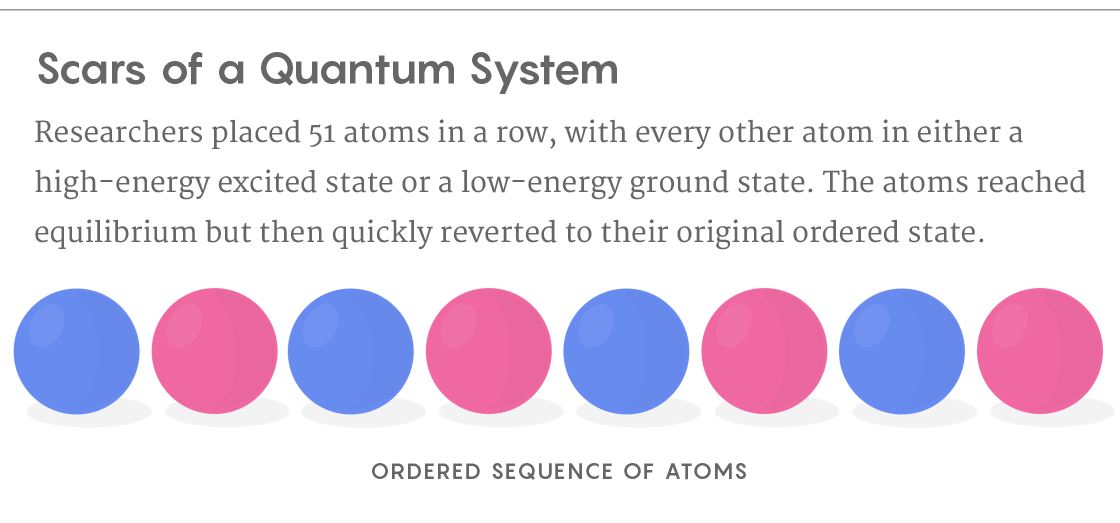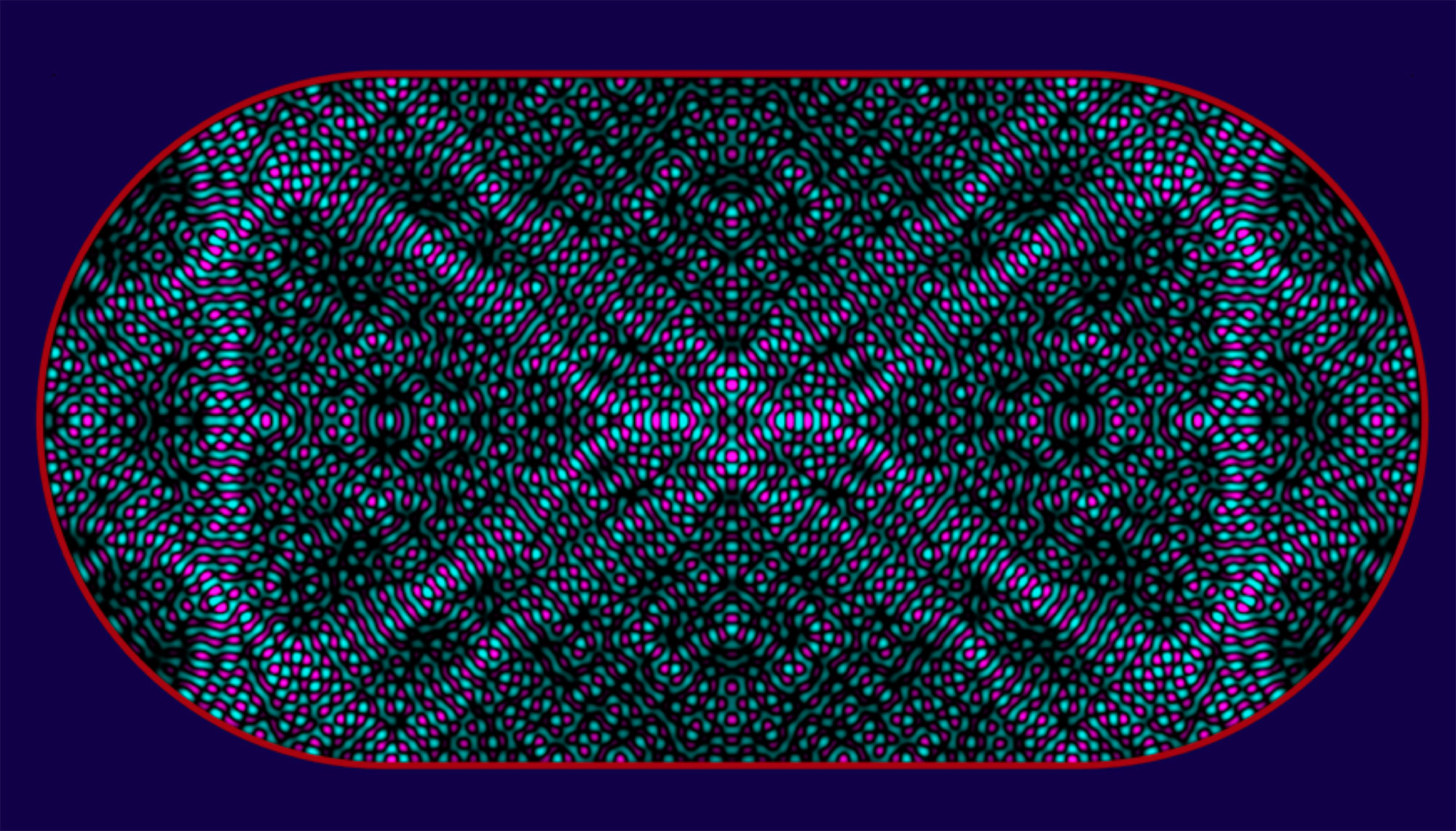Quantum Machine Appears to Defy Universe’s Push for Disorder
Introduction
Given enough time, even a tidy room will get messy. Clothes, books and papers will leave their ordered state and scatter across the floor. Annoyingly, this tendency toward untidiness reflects a law of nature: Disorder tends to grow.
If, for example, you cut open a pressurized scuba tank, the air molecules inside will spew out and spread throughout the room. Place an ice cube in hot water and the water molecules frozen in the ordered, crystalline lattice will break their bonds and disperse. In mixing and spreading, a system strives toward equilibrium with its environment, a process called thermalization.
It’s common and intuitive, and precisely what a team of physicists expected to see when they lined up 51 rubidium atoms in a row, holding them in place with lasers. The atoms started in an orderly pattern, alternating between the lowest-energy “ground” state and an excited energy state. The researchers assumed the system would quickly thermalize: The pattern of ground and excited states would settle almost immediately into a jumbled sequence.
And at first, the pattern did jumble. But then, shockingly, it reverted to the original alternating sequence. After some more mixing, it returned yet again to that initial configuration. Back and forth it went, oscillating a few times in under a microsecond — long after it should have thermalized.
It was as if you dropped an ice cube in hot water and it didn’t just melt away, said Mikhail Lukin, a physicist at Harvard University and a leader of the group. “What you see is the ice melts and crystallizes, melts and crystallizes,” he said. “It’s something really unusual.”
Physicists have dubbed this bizarre behavior “quantum many-body scarring.” As if scarred, the atoms seem to bear an imprint of the past that draws them back to their original configuration over and over again.

Lucy Reading-Ikkanda/Quanta Magazine
In the 16 months since the result was published in Nature, several groups of physicists have tried to understand the nature of these quantum scars. Some believe that the discovery might herald a new category for how quantum particles interact and behave — one that defies physicists’ assumptions that such a system follows an inexorable march toward thermalization. In addition, this scarring effect could lead to new kinds of longer-lasting quantum bits, key ingredients in any future quantum computer.
Overcoming Zero Probability
Indeed, when the physicists built their 51-atom system, they had their eye on quantum computing. The system was, in fact, a quantum simulator, a machine designed to simulate quantum processes that are otherwise impossible to investigate with a classical computer. At the time, the machine was the largest quantum simulator ever built.
The atoms in the Harvard machine serve as qubits, their on-off states being either the ground state or an excited state called a Rydberg state. The system allows researchers to tune it as they wish, for example by adjusting how strongly the atoms interact with one another.
The researchers prepared several initial configurations of ground and excited states. Because the atoms strongly interact with one another, they should thermalize. Instead of intermingling like gas molecules, though, the atoms in this kind of quantum system develop deep quantum connections with one another, called entanglement. “Then entanglement will just spread,” Lukin said. “That’s how thermalization occurs.”
Usually, entanglement did grow in the simulator. Yet when the researchers started the experiment in a configuration of alternating excited and ground states, the particles became entangled and then disentangled, oscillating as they moved in and out of their original configuration.
The behavior seemed unlikely to the point of being impossible. Once the atoms start interacting, their alternating pattern should quickly become forgotten, since the atoms can transition into an enormous number of possible sequences of excited and ground states. It’s like the case of the scuba tank, in which the air molecules escape their initial configuration inside the tank and disperse through the room. There are so many possible places for the molecules to explore that the probability that all of them will spontaneously squeeze back into the tank is effectively zero.
“The available quantum system can exist in so many possible states that it would be extremely hard for them to come back and find where they came from,” said Zlatko Papić, a physicist at the University of Leeds in England.
Yet that’s exactly what Lukin said they observed. The system seems to be imbued with some special physics that allows it to retrace its path, Papić said. “It leaves bread crumbs and goes back to where it came from.”
“This was the first real discovery which was made with a quantum machine,” Lukin said.
Lukin and colleagues started to write up the experiment, but before the paper was published, Lukin described it at a conference in Trieste, Italy, in July 2017. “We didn’t know what to make of it,” said Papić, who was in the audience that day. “I don’t think anyone in the audience had an idea for what could be the reason for this.”
Scars in a Stadium
Soon enough, however, Papić and colleagues realized this behavior was reminiscent of a phenomenon discovered roughly 30 years ago.
In the 1980s, the physicist Eric Heller of Harvard was exploring quantum chaos: What happens when you apply quantum mechanics to chaotic systems? In particular, Heller considered how a billiard ball bounces inside a “Bunimovich stadium” — a rectangle capped by semicircles. The system is chaotic; given enough time, the ball will cover every possible trajectory inside the stadium. But if you start the ball at a certain angle, it will instead retrace the same path forever.
In a thought experiment, Heller replaced the ball with a quantum particle. “The naive expectation is that if your classical system is already chaotic,” Papić said, when you add the rules of quantum mechanics “you should expect even more chaotic behavior.” The particle’s wave function — the abstract mathematical encapsulation of its quantum properties — should get smeared across the stadium just as water waves undulate throughout a pond. The likelihood that you’ll find the particle in a given place should be the same everywhere in the stadium.

A particle placed in a Bunimovich stadium can show scars along the trajectories where it’s likely to be found.
Eric Heller
But Heller discovered that instead of spreading out, the particle’s wave function congregates along the same paths as in the special classical case where the ball retraces itself. It’s as if the waves develop a memory of this special trajectory. “It’s like going home for them,” Heller said. “They really want to go back to where they’re born. It’s that simple.”
While hanging out along this trajectory, the particle’s wave constructively interferes with itself — crests add to crests and troughs add to troughs. As a result, the particle is most likely to reside somewhere along this path. On a graph, the particle’s probability distribution resembles fuzzier versions of those classical periodic trajectories. “They look to me like scars,” Heller said. So, in his 1984 paper, that’s what he called them.
Maybe a similar phenomenon could explain why the 51-atom system kept coming back to its initial configuration, Papić thought. Maybe it, too, was homesick.
The Cut That Makes the Scar
To find out, Papić and his colleagues analyzed the quantum states of a model of the 51-atom system. Its weird oscillating behavior, they found, did in fact seem similar to Heller’s quantum scarring. They identified states that resembled the special states that correspond to scarred trajectories. By periodically returning to those states, the system could avoid thermalization. The connection to quantum scarring was suggestive enough that, in a paper last year in Nature Physics, they dubbed the phenomenon “quantum many-body scarring.”
Despite some initial skepticism of Papić’s analysis, Lukin, along with Wen Wei Ho, a physicist at Harvard, and others, then made the link to quantum scarring more explicit in a paper published in January. They identified a classical way to describe the state of the 51-atom system as a point in abstract space. As the system’s state changes, the point moves around. The researchers found that when the system undergoes its weird oscillations, the point sloshes back and forth in a manner akin to a ball’s special periodic paths across the stadium billiard table.

A view of the lab where researchers built the 51-qubit quantum simulator.
Courtesy of Mikhail Lukin
By finding a classical analogy, the researchers strengthened the case that Heller’s single-body phenomenon does in fact apply to a many-body system. “These guys are on to something,” Heller said. “They really are.”
What’s clear is that the experiment has triggered the interest of researchers around the world. One group at the California Institute of Technology has identified the mathematical expressions that represent some of the special scarring states of the 51-atom system. Another at Princeton University has suggested that scars could be a broader phenomenon with applications in different areas of condensed matter physics. “We kind of think we understand what’s happening in this system,” Ho said. “But we still don’t have a general recipe for when you can find other scarred trajectories.”
And deeper questions remain. “‘Scars’ is a useful description of the problem,” said Vedika Khemani, a physicist at Harvard who is not involved with the experiment. “But I still don’t think we have any understanding of what causes the scar.”
Structure in the Randomness
Despite these unknowns, many-body scarring excites physicists because it could represent a new class of quantum system.
Over the past few years, physicists have been exploring another such class, called a many-body localization, where random impurities prevent a system from thermalizing. As an analogy, consider a herd of cows wandering around a flat landscape. The cows should eventually spread out — call it bovine thermalization. But if the landscape features random hills, the cows will instead find themselves stuck in the valleys.
Similarly, the quantum many-body scarred system isn’t a chaotic, thermalizing system. Yet it doesn’t have anything like hills. “This work suggests there’s a new class of system that’s in between these two things,” Papić said.
To explain the scarring effect, Khemani’s recent analysis suggests that the 51-atom system might be (at least close to) what’s called an integrable system. Such a system is a special, isolated case, with many constraints and features that are tuned in a way that prevents it from ever thermalizing. So if the scarring system is integrable, it might be a unique case of a broader class of phenomena.
Physicists have been studying integrable systems for decades, and if this system is integrable, Papić said, the implications are less compelling than if it is a unique quantum system. Papić, Ho and Lukin have written a paper that argues against this possibility.
Regardless of whether many-body scarring is indeed a new class of quantum behavior, the discovery points to the tantalizing prospect that it might eventually be used to improve quantum computers.
One of the challenges of building a quantum computer is the need to protect its fragile qubits. Any disturbance or perturbation from the outside environment can cause the qubits to thermalize, erasing any stored information and rendering the computer useless. “If you can find a generic way to induce scarring in other systems, then maybe you can protect quantum information for a long time,” Ho said.
Scarring, then, might offer a way for the computer to cling onto memory, preserving the past before the chaos of thermalization wipes it away.
“There is some beautiful structure that somehow coexists with a totally random environment,” Papić said. “What kind of physics allows this to happen? This is a kind of deep and profound question that runs through many areas of physics, and I think this is another incarnation.”
This article was reprinted in Spanish at Investigacionyciencia.es.



